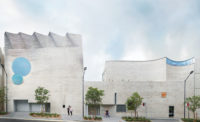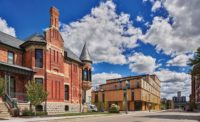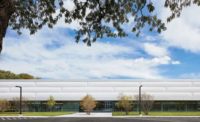Designed by John Wardle Architects (JWA) and NADAAA, the Tanderrum pedestrian bridge is a significant contribution to the city of Melbourne’s public infrastructure. The tanderrum is an indigenous Australian ceremony that welcomes visitors onto traditional aboriginal lands and affords them safe passage—and the Tanderrum Bridge is welcoming indeed. Linking the terraced recreational spaces of Birrarung Marr to Melbourne Park, the home of the Australian Open Grand Slam tennis tournament, the bridge forms a new public entrance to one of the key arenas of Melbourne’s sporting precinct.
Additional Content:
Jump to credits & specifications
The bridge is important because Melbourne’s public spaces, however picturesque, are dispersed: Melbourne’s rational city grid was laid out in 1837, by the surveyor Robert Hoddle with little regard for topography, existing structures, or the inclusion of open space. As a consequence of this heavy-handed planning, Melbourne’s public realm—its leisure spaces, arts institutions, and sporting grounds—were pushed to the fringes of the city, not contained but loosely bounded by the thresholds of the city’s built edge, the Yarra riverbank, and a mosaic of peripheral parklands.
As a result, the connections between these spaces are fundamental to the sustainability of a vibrant public realm, and walkability is paramount. The Melbourne and Olympic Parks sporting precinct forms an urban island cut off from the city by train lines to the north and from the river by one of the primary roads into the city. The 1,280-foot-long bridge has opened this island up to pedestrian traffic from both the city and the river. It is the centerpiece in a strategic state-government master plan for the precinct that will enable better pedestrian permeability for sports-obsessed locals and visitors.
To get to the bridge from the city, you walk east along the banks of the Yarra River toward Melbourne Park. The Tanderrum is one of three pedestrian bridges that form an intricate net connecting Birrarung Marr—“a place beside the river of the mists”—to the city and sporting precincts. The bridge’s complex and rich relationship to the surrounding landscape is due to a close working relationship between the architects and the landscape architecture and urban design firm Oculus. Articulated rather than axial, the bridge does not reveal itself all at once. Instead, the journey along it is a process of unfolding discovery.
The bridge rises gently, held by the ferncovered berm defining the edge of Birrarung Marr’s middle terrace, hovering above a swale filled with pale gravel and eucalyptus like a serpent in a dry riverbed. As it reaches the top of the berm, the bridge divides into two serpentine branches. The northern one leads to a large open terrace, which is periodically occupied by temporary structures such as circus tents and shelters for outdoor music events. The southern branch is a moment of respite, forming a balcony that looks out across a park that was once Melbourne’s Speakers Corner, and through a canopy of elms to the river and across it to the arts district. John Wardle describes this contemplative spot as “borrowing from the landscape and the history of the site.”
The bridge itself is an elegant thing: separating its skin from its structure—steel box girders and concrete pylons—enabled the architects to create a slender profile. The rhythmic filigree of painted tubular steel balustrading that wraps the underside of the bridge enhances this, extending upward periodically to create points of illumination.
This filigree exemplifies the richness of the collaboration between Melbourne-based JWA and New York– and Boston-based NADAAA. This is the second collaboration for the firms—the first was the Melbourne School of Design, which, like the bridge, was awarded through an international competition. The filigree draws on NADAAA’s research into the structural complexities of materiality enabled by digital modeling and new technologies. It also reflects JWA’s obsession with the idea that a detail should articulate its making— that it should speak of the human element in the crafting of architectural form. The intricacy of the filigree was digitally modeled, and constructed in sections of cold-rolled steel tubes, folded like three-dimensional paperclips in a multiaxial bending machine. The fabricators used a fine welding technique that required no pre-finish prior to painting. This attention to detail shows. For Wardle, the human characteristics embodied in the act of making are “pronounced and amplified in the expression of the bridge.”
The Tanderrum plays between presence and absence, striking a balance between form and landscape. It is experienced from above and below, from road and parkland. It is sometimes present, as a gateway to the city from the road, and sometimes it recedes into the background, camouflaged by its transparency and the moiré effect the filigree creates in the surrounding trees. The bridge rises to a high point over Batman Avenue and falls again, emptying people into the heart of Melbourne Park, adjacent to the vivid blue of the tennis courts. In full event mode during the Australian Open, it is truly a wonderful way to enter into the spirit of the tournament, allowing the crowd to spill out across the road that divides the tennis center from the parkland, and using the formal landscape of Birrarung Marr as additional event space, drawing all the action of “a day at the tennis” closer to the city.
The Tanderrum Bridge is a formal manifestation of cultural significance and of social connection through the development of a vibrant walkable public realm, drawing history together with context, landscape with structure. Nader Tehrani, one of NADAAA’s founding partners, reflects on its relation to his research into materials and Melbourne’s complex civic geometry. “It’s no longer something you make in an artistic void. All of a sudden, it has a much more profound connection to the community it serves, the infrastructure of the city, the landscape it sits within—it is part of the culture of the city and it is also something that produces the culture of the city.”
CreditsArchitect: NADAAA
Personnel in architect's firm who should receive special credit: NADAAA: Nader Tehrani, Arthur Chang, Parke MacDowell, Thomas Tait, Nick Safley Engineers Structural: GHD Consultants Landscape Architect: Oculus
General contractor: Fitzgerald Constructions Australia and Harris HMC
Photographer: Kristoffer Paulsen kris@kristofferpaulsen.com Peter Bennetts studio@peterbennetts.com pb@peterbennetts.com Erieta Attali ha2122@columbia.edu Nils Koenning nk@nilskoenning.com
|
SpecificationsStructural System Fabricated steel plate box girder beams
Exterior Cladding Metal panels: Fabricated 34mm diameter steel tube 'filigree' balustrading
|
















